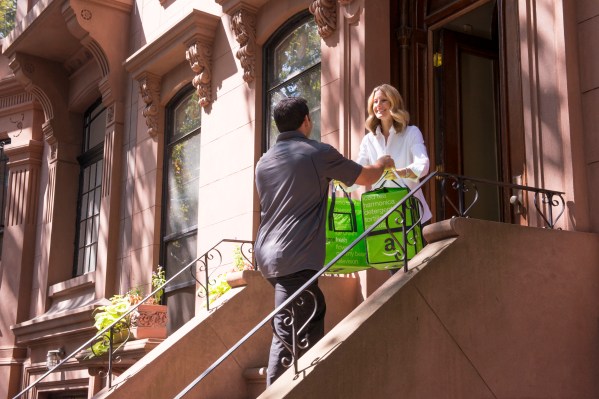Amazon’s online grocery shopping service, AmazonFresh, is expanding once again – roughly a long hiatus. Following its arrival in London earlier this month, the retailer announced on Tuesday that it would now make the service available to customers in Boston, Massachusetts in select neighborhoods. The city now joins the other AmazonFresh markets in the U.S., including Seattle, Northern California, Southern California, New York metro, Northern New Jersey, Philadelphia metro, Stamford, CT and Baltimore.
In Boston, AmazonFresh will be open to areas including Charlestown, Beacon Hill, Back Bay, Jamaica Plain, Brighton, Allston, and others.
Customers can use the service to shop for fresh groceries online, like dairy, meat and fresh fruits and vegetables, as well as prepared meals, health and beauty products, pet supplies, baby products, and other household goods. There are over 95,000 different items available at launch, which can be delivered same-day if the orders are placed by 10 AM, or next-day, if ordered later. If you place an order by 10 PM, Amazon says it can deliver your items by “breakfast” time.
Shoppers can also choose between unattended or attended two-hour delivery windows.
In addition, Boston customers can choose to shop from local markets through the service, including Savenor’s Market, Chestnut Farm, Red’s Best, or the nonprofit incubator in Dorchester, CommonWealth Kitchen.
What hasn’t changed with the expansion in the region is AmazonFresh’s pricing. The company has struggled to make the economics of grocery delivery work, which makes the service pricier compared with its venture-backed competitors, like Instacart.
To purchase an AmazonFresh membership, customers have to subscribe to “Prime Fresh,” which is an upgraded Prime membership that offers all the advantages of Prime, but costs $299 per year – or $200 more than the current cost of Prime alone, if paid annually.
Meanwhile, competing delivery services like those from Instacart, Peapod, Shipt, FreshDirect, and others, tend to make money by marking up the prices on the groceries, per-delivery fees, and upgrades to other, less-costly annual memberships for free deliveries on orders over a certain size. (For example, Instacart charges $149/year for Instacart Express which provides free delivery on orders over $35.)
But where competitors have largely partnered with local grocers, meaning their employees and contractors simply go to stores, shop, and make deliveries as orders come in, Amazon instead has been investing in refrigerated warehouses and inventory. That has slowed its ability to expand at a quicker pace.
In the Boston area, for instance, Amazon built a 1.2 million-square-foot warehouse and fulfillment center in Fall River and leased 96,600 square feet of refrigerated space in Everett, The Boston Globe reports.
Another point of concern is that AmazonFresh hasn’t been Amazon customers’ only option for grocery and household items, which has added confusion. The company also offers a Prime Pantry service for packaged goods, and it partners with some local grocery stores to offer a more limited selection of perishables with its Prime Now service, available in a number of major metros across the U.S.
Combined with the higher price point, it’s unclear what consumer demand will be for AmazonFresh as it expands. That said, getting grocery delivery right – something Amazon has tested since 2007 – could be a longer-term play for the company. Amazon is also experimenting with other things in this space that could ultimately bring costs down for consumers, including drive-up grocery stores, and its own collection of private label items including those for foods, diapers and laundry detergents.
Correction: AmazonFresh expanded in March in Baltimore and Sacramento; a report we cited said it had been 18 months since new expansions, but this was not accurate, Amazon says. The post has been updated to reflect.
